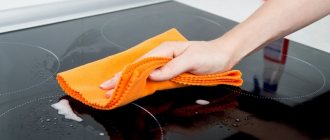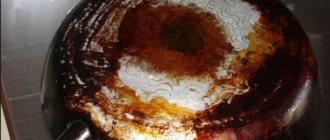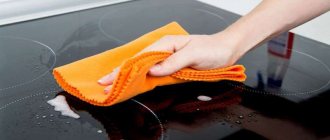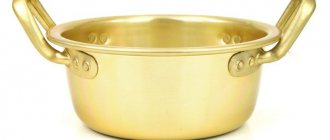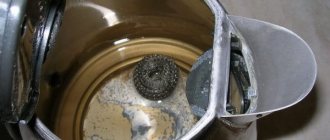How to clean a stainless steel hob
Modern household appliances are not only practical and easy to use, but also look very aesthetically pleasing and beautiful. A special charm and elegance are inherent in household appliances made from stainless steel. The noble shine of metal surfaces and the clarity of lines will amaze any housewife!
But, unfortunately, stainless steel household appliances, especially gas and electric stoves, with frequent use and improper care, very quickly come to a very unaesthetic state: the surface becomes cloudy or covered with small scratches.
You will learn how to wash a stainless steel stove so that it lasts a long time and is in excellent condition.
Basic rules for washing stainless steel plates
- Try to wipe down the stove immediately after cooking. While the stove is still warm, you can wipe it with a soft damp cloth and any liquid dishwashing detergent (products such as Feri or Drop are excellent).
- Under no circumstances should stainless steel plates be washed with abrasives. For example, Pemolux in powder will have an extremely negative effect on the surface of the slab: over time, small cracks will appear on it.
- Under no circumstances should you scrub the stove with hard or metal brushes. Even a brush or a soft wire metal sponge will damage the surface of the slab.
- Under no circumstances should you wash the surface of a stainless steel stove with products containing chlorine - this may cause the stove to become covered with whitish spots, which will be almost impossible to remove.
- The best way to wash the stove is with special products suitable for washing stainless steel surfaces, which are now abundant in stores.
When choosing a product for cleaning stainless steel surfaces, I settled on Dr. Beckmann Stainless Steel Cleaning Foam (made in Germany), suitable for glossy and matte stainless steel surfaces, as well as chrome surfaces.
This product can be used to wash not only kitchen stoves, but also sinks, taps, hoods, and other household appliances made of stainless steel.
The method of application is very simple: spray, wipe, rinse and polish. It washes away everything, greasy drops, oxidation stains, and hand marks. And it will even wash off food that has dried on the stove!
In addition to a product for cleaning stainless steel household appliances, any housewife will need information about other home cleaning products. You can read about this by following the link: Household cleaning products, tips from housewives or on the pages of our website Sizhu-doma.ru.
The main stages of washing a stainless steel stove
Let me make a small disclaimer. The idea of writing an article about how to wash a stainless steel stove came to me after returning home from a multi-day business trip, during which my younger generation and my husband not only heated lunches and dinners they had prepared for future use, but also cooked dumplings and even buckwheat porridge themselves.
In fact, it was the buckwheat porridge that had thoroughly dried onto the stove that caused my family the greatest difficulty in cleaning the stove. And she waited for me.
Remove the grate from the stove
To speed up the washing process, you can apply any dishwashing liquid or kitchen detergent to the grate. As a rule, the grate for gas stoves is made of a very dense and wear-resistant material (mainly cast iron), so the grate can be washed with any abrasive agent.
While our grate is “soaking”, let’s work on the stove.
Treat the stove with detergent
Under no circumstances should you rub the surface!
Scraping burnt or dried-on food from a stainless steel cooktop can damage the surface, leaving unsightly scratches.
It is best to coat the entire surface of the stove with detergent and leave for a few minutes.
You need to wash the stove grate both on top, the surface on which food is cooked, and on the bottom - pieces of burnt food also remain there.
For quickness and convenience, you can take a dishwashing sponge, apply a cleaning agent to the abrasive (harder) surface, wrap the sponge around individual sections of the grill, and using rubbing movements, thoroughly rinse all parts of the grill. After which the grille is rinsed and wiped with a soft cloth.
Cleaning the stove
If the stove is in very bad condition and food residues are difficult to remove from the surface of the stove, you can spray a little more detergent, focusing on the most difficult areas, and wait a little longer.
After this, remove any remaining food and foam with a sponge, rinse the sponge, and wipe again until the stove is clean.
At this stage, the cloth must be rinsed several times, completely removing any remaining detergent.
Thoroughly rinsing the cloth when washing helps avoid possible stains on the stove.
Wipe dry and collect
We wipe our stainless steel stove with a soft, dry cloth or kitchen towel, “rubbing” it until it shines.
After this, we assemble the stove, installing both the gas heads and the grate in place.
It took me about twenty minutes to wash the stainless steel stove, even in such neglected condition. At the same time, I was in no hurry and did not rub the surface of the stove “until I lost my pulse.” It was enough to simply apply stainless steel cleaning foam to the stove and then wash it off!
Yes, I use the same product to wash faucets in the kitchen and bathroom, and other household appliances made of stainless steel.
What product are you using?
Sometimes it is better to see how it is done once than to read it several times. I suggest watching a video of how to wash a stainless steel gas stove in practice.
[/su_box]
In fact, in order to wash a stainless steel stove, only 15 minutes is enough, no more.
Kitchen appliances made of stainless steel compare favorably with other stoves with a chic, presentable appearance. A shiny metal surface requires more careful care than, for example, an enamel coating: even small drops of water leave stains after drying , which will be noticeable and create an untidy appearance.
When should you clean your stainless steel appliance?
The high-alloy steel used in the production of plates is enriched with chromium.
As a result of the interaction of this element with oxygen, a film of insoluble oxides is formed on the metal surface, which prevents corrosion.
How to clean a stainless steel hob
Modern household appliances are not only practical and easy to use, but also look very aesthetically pleasing and beautiful. A special charm and elegance are inherent in household appliances made from stainless steel. The noble shine of metal surfaces and the clarity of lines will amaze any housewife!
But, unfortunately, stainless steel household appliances, especially gas and electric stoves, with frequent use and improper care, very quickly come to a very unaesthetic state: the surface becomes cloudy or covered with small scratches.
You will learn how to wash a stainless steel stove so that it lasts a long time and is in excellent condition.
How to clean a stainless steel stove
There is a clear algorithm of actions that allows you to thoroughly clean the slab and maintain its original appearance. To implement it you need:
- remove all utensils from the stove surface;
- disconnect the device from the power source and shut off the gas in the pipe;
- disassemble the upper tier, remove the burners from the base and the handles from the control panel (if possible);
- put on rubber gloves;
- remove all small crumbs and unstable stains from the stove with a soft sponge;
- soak stubborn stains by placing wet rags soaked in detergent on them;
- open the windows and ventilate the room if the chosen product has a persistent chemical odor;
To prevent stains from remaining on the stainless steel plate, you need to wipe the metal parts with point-to-point pressure at the final stage.
Means and tools
Fresh dirt can be easily removed. If they have time to “set” and dry completely, you will have to make great efforts to maintain cleanliness. Special tools will help facilitate this process. You can use those that will not cause the formation of microscopic scratches. To wash stainless steel, experts recommend choosing:
- melamine sponge: it makes it easier to remove simple stains;
- microfiber cloth: helps remove a variety of stains;
- paper towels: return a metallic shine to wet stainless steel.
In order not to make a mistake in choosing the appropriate composition, you can go to a specialized store and ask the sales consultant how to clean a stainless steel stove at home. He will definitely advise and show you a whole line of household chemicals. It is better to choose products with a liquid or creamy consistency. Such cleaners will not be able to spoil the smooth, even surface of the metal; they will help to carefully clean the stove without causing small scratches. On the packaging of each composition there is a mark that allows you to find out what it can fight against: grease, soot, stubborn greasy stains or burnt milk.
There are universal creams such as E6SCC106. They are designed to combat any type of pollution. The product is easily sprayed on the surface and foams well. The bottle contains detailed instructions for use. By following it, you will be able to quickly clean the stove without much effort.
Manufacturers produce compounds that simultaneously clean stainless steel and polish its surface. They are suitable for cleaning enameled slabs and panels made of aluminum.
"Kenolux" is produced in the form of a spray. The cleaning liquid is applied by spraying. The composition quickly dissolves stubborn stains. After its use, a thin film is formed on the surface of the product, protecting it from dirt. After use, the product does not need to be washed off. It is anti-allergenic and does not have a persistent chemical odor. However, you need to work with it carefully, first putting on rubber gloves.
Folk remedies
If you don’t have a suitable chemical composition at hand, you can replace it with something that is always on hand in any home. To clean burnt milk from stainless steel, you need to take several tablets of activated carbon from the first aid kit and crush them into powder. Use rags to collect any spilled liquid and sprinkle black powder on exposed stains. Fill with water and wait ten minutes. Rinse the surface thoroughly with water and rags.
Delicious recipe! What to cook from honey mushroom caviar
Grease stains can be easily removed with regular baking soda. The surface of the stove is first washed with soapy water and then dried with a rag. After this, white powder is liberally sprinkled onto the dirty areas. After half an hour, a small amount of water is added to it. The resulting slurry is removed with a damp sponge. This cleaning method produces a mild abrasive effect that works well against greasy stains, but does not scratch the surface of the slab.
You can clean a stainless steel gas stove using lemon juice or diluted vinegar. Soak a sponge in one of the components and walk over the dirty surface; remove any remaining product with a damp cloth. The remaining drops of water must be collected with paper towels, then there will be no streaks left on the stove, and it will shine like new.
Too serious stains can be removed with a mixture of office glue and baking soda. To prepare the solution, take five liters of water. They add 100 ml of glue and 100 grams of soda. The mixture is thoroughly stirred, heated in a water bath, and then applied in a thin layer to the surface of the stove. After thirty minutes it is removed with a wet cloth. Even the most stubborn stains easily come off with it.
How to care for a stainless steel stove
The described household appliances look great in a modern interior. It has an impact-resistant coating that can last for decades. To maintain the attractive appearance of the stove, you need to properly care for it: clean it every day, immediately clean up spilled liquids, clean out burnt food. It is important to remember that fresh stains are easier to deal with.
You need to choose the right cleaning agent and try to use only one: a mixture of different compositions will provoke the development of a chemical reaction that can damage the front protective matte or glossy layer of the slab.
We bought a Hotpoint Ariston PC 640 NX /HA stainless steel hob. And immediately upon first use it dripped onto the surface. It wiped off easily with a soft sponge, but there were slightly lighter marks left in the place where there were three spots. I decided to cover it with foil (even though I really didn’t want to do this). Yesterday I was cooking again and the water ran out. In the evening I decided to replace the foil. I lift it up, and there are traces of water that has escaped.
Possible contaminations and their causes
During operation, the cookware comes into contact with food, water, fats, and acids. On the surface, in addition to food, other types of contaminants are formed.
Nagar
During cooking, fat splashes onto the internal and external surfaces of the cookware. First they create a thin yellow film. It's sticky and durable. If it is not removed, carbon deposits will form on the surface. It is a dark, thick crust.
"Rainbow" on the bottom and walls
Rainbow stains appear on the bottom and walls if an empty pan is overheated. Under the influence of high temperatures, the protective film on the steel surface thickens. It creates the rainbow effect. The operational properties of the product are preserved.
Scale
Limescale appears on the bottom of a kettle or pan. It means the water is hard. It contains mineral salts. The color of the plaque depends on what minerals are dissolved in the water. It can be white, gray, red.
How to care for a stainless steel stove: methods and useful tips
Stainless steel plates are very popular today. For this reason, housewives often have a question: what and how to wash such a stove? Compared to regular steel, stainless steel is famous for its increased resistance to corrosion. A plate made of this material looks stylish and beautiful. But every coin has two sides.
The disadvantage of a stainless steel plate is that its surface requires more painstaking care, which requires the use of special products. Incorrectly selected cleaning products can leave stains and scratches on the surface of the stove, which will be difficult to remove. The stainless surface must also be polished at the final stage of cleaning.
From this article you will learn about the features of caring for a stove made of stainless steel.
Caring for a stainless steel stove
There are two types of steel plates - mirror and matte. Based on this, it will depend on how to clean and care for the stove. Hardware stores these days are replete with hob care products. It is best to use creamy and liquid products, rags, and soft sponges. These products will not spoil the beauty or harm the surface. If it is impossible to buy a special product at the moment, you can prepare it yourself at home.
Under no circumstances use acid-containing substances, sand, soda, detergents with abrasive particles and chlorides, or rough materials on stainless steel surfaces. Polished stainless steel will not tolerate graters, hard sponges and brushes.
Below is a list of available products that will help cope with various types of contamination on a stainless steel stove:
- To dissolve burnt marks and wash away greasy stains, you should use concentrated soap-containing detergents that are used for washing dishes - “Myth”, “Pemolux”, “Adj”, “AOS”, “Fairy”.
- A steel surface made of stainless steel can be protected and cleaned using “Cillit Bang”, “Cif”, “Top House”, “Steel Shine”, “Lux”.
- "Domax", "Wpro 29945" will help polish and clean the surface.
- Difficult stains and old grease can be removed with a special cleaning agent – “Shumanit”. This drug is toxic and aggressive.
- Using any glass cleaner you can clean small stains. After using this product, the surface will shine like a mirror, and there will be no streaks left.
- Eco-friendly products “Ecos”, “Amway”, “Almawin” will allow you to avoid the harmful effects of chemicals on the skin of your hands, as well as environmental pollution. You can use lemon juice and mustard powder.
- Various types of dirt can be easily removed with a melamine sponge. It does not scratch the surface, and its open pores absorb soft dirt well.
- A microfiber sponge will help wash away stains that form when washing the stove.
- Paper towels are great for adding shine.
Cleaning a stainless steel stove
It is necessary to study the recommendations before washing a stove made of stainless steel. Here are some of them:
- All items that are on the sink and near it should be removed from the stove. The cleaning agent will not get on them and they will not interfere with the cleaning process.
- The technical features of the stove should be taken into account. If it is electric, you must turn it off from the power supply.
- It is necessary to determine the possibility of removing regulators and burners. Remove them from the nest if possible.
- Protect your hands with rubber gloves. This will make it possible to avoid allergic reactions on the skin.
- Be sure to read the instructions for the product you choose.
- It is important that the room you are in is well ventilated if the chosen product has a strong or specific odor.
- Before using the product, first test it on a small area of the slab that is less noticeable.
- Chemicals of different compositions should not be mixed together. This will prevent the appearance of unexpected stains and the formation of toxic substances.
Next, you need to act in such a way that the electric or gas stove is washed as quickly as possible:
- Use a sponge or soft cloth to sweep away any crumbs from the surface of the stove.
- Wet a sponge in warm water and moisten the hob with it. The frozen dirt will get wet.
- Moving in one direction, remove the main contamination with collecting movements.
- Apply the cleaning agent to the sponge and treat the stove. Pay special attention to problem areas.
- Remaining foam is removed with a clean and damp cloth.
- Spray the polishing agent over the surface.
- Wipe everything dry with a napkin or paper towel.
By wiping the hob with pointed movements, you will prevent the formation of streaks.
Useful tips
To ensure that a stove made of stainless steel always pleases you with an attractive appearance, you need to adhere to some rules:
- A fresh stain of dirt is much easier to wash off than an old one. Therefore, make it a rule to wipe the surface of the stove every day after cooking. For this, she will delight you with newness and purity.
- Pay special attention to cleaning the stove body.
- A water-repellent protective layer on the stove will help create a special oil for stainless steel surfaces.
After reading this article, you learned how to wash and care for a stainless steel stove. Our tips will help you protect it from unwanted stains. It will always look new and beautiful and will serve you for a long time.
Source: https://ratatum.com/kak-pravilno-uhazhivat-za-plitoj-iz-nerzhavejushhej-stali/
Principles of cleansing at home
Tips for caring for stainless steel are very simple. They are easy to follow.
What not to use
List of products and devices that should not be used when using stainless steel cookware:
- Dishwasher;
- metal sponge;
- a cleaner containing abrasive components.
How to use baking soda and salt
Salt and soda are essential care products for stainless steel cookware. The principle of their use is simple:
- the product is washed;
- apply soda, salt or a mixture thereof to the contaminated area;
- rub the powder in a circular motion.
After cleaning, the item is rinsed with water and dried with a towel.
Timeliness
Regular cleaning of stainless steel pans eliminates the appearance of old stains. It takes little time to remove fresh stains.
To avoid divorces
After each wash, wipe the dishes dry with a kitchen towel. There are no streaks on a clean, dry surface.
How to wash a stainless steel stove
Modern household appliances are not only practical and easy to use, but also look very aesthetically pleasing and beautiful. A special charm and elegance are inherent in household appliances made from stainless steel. The noble shine of metal surfaces and the clarity of lines will amaze any housewife!
But, unfortunately, stainless steel household appliances, especially gas and electric stoves, with frequent use and improper care, very quickly come to a very unaesthetic state: the surface becomes cloudy or covered with small scratches.
You will learn how to wash a stainless steel stove so that it lasts a long time and is in excellent condition.
Wipe dry and collect
We wipe our stainless steel stove with a soft, dry cloth or kitchen towel, “rubbing” it until it shines.
After this, we assemble the stove, installing both the gas heads and the grate in place.
It took me about twenty minutes to wash the stainless steel stove, even in such neglected condition. At the same time, I was in no hurry and did not rub the surface of the stove “until I lost my pulse.” It was enough to simply apply stainless steel cleaning foam to the stove and then wash it off!
How to clean a stainless steel stove? — ServiceYard - the comfort of your home is in your hands
Stainless steel plates are very popular today, so the question often arises among housewives: how to wash a stainless steel stove? This material is famous primarily for its increased resistance to corrosion compared to conventional steel, and besides, a plate made from it looks beautiful and stylish.
However, there are a number of inconveniences, which consist in the fact that a metal surface requires more painstaking care and the use of special products, since the incorrect selection of cleaning agents will be reflected on the surface in the form of scratches and stains that cannot be removed in any way. Another feature of a stainless surface is that it requires a more thorough approach to the final stage of cleaning - polishing.
Are you wondering how to clean your cooktop without streaks? You will learn about all the features of caring for a stainless steel stove from this article.
How to clean a stainless steel stove?
Steel plates come in two types - matte and mirror, which require a different approach to care and cleaning. Nowadays, hardware stores are replete with products for various types of cooking surfaces, including stainless steel ones. In order not to spoil the surface and reduce the beauty of its appearance, when cleaning, use liquid and creamy products, soft sponges, and rags. If you do not have the opportunity to purchase the appropriate product, you can prepare it at home.
Important! To clean a stainless surface, do not use: rough materials, detergents with chlorides and abrasive particles, soda, sand, acid-containing substances. To avoid damage to polished stainless steel, any brushes, hard sponges or graters are unacceptable.
We bring to your attention a list of special products that will help you get rid of various types of dirt and easily solve the problem of how to wash a stainless steel stove, in accordance with your financial capabilities:
- To wash away greasy stains and dissolve burnt marks, use soap-containing concentrated dishwashing detergents such as “Fairy”, “AOS”, “Adj”, “Pemolux”, “Myth”.
- You can clean and protect the steel surface using special products for stainless steel: “Lux”, “Shine of Steel”, “Top House”, “Cif”, “Cillit Bang”.
- The following products will help you clean and polish stainless steel: “Wpro 29945”, “Domax”.
- Old grease and stubborn stains can be removed with a special cleaning agent – “Shumanit”, but please note: the drug is highly aggressive and toxic!
- Small stains can be cleaned using any glass cleaner. After using this product, there are no streaks left, and the surface will shine like a mirror.
- To avoid environmental pollution and the harmful effects of chemicals on the skin of your hands, use eco-friendly products from the following brands: Almawin, Amway, Ecos, and you can also use improvised products such as mustard powder and lemon juice.
- Melamine sponge - easily removes various types of dirt. The open pores of the sponge perfectly absorb soft dirt without scratching the surface.
- A microfiber sponge will help wash away stains caused by washing the stove.
- Paper towels are great for adding shine.
Important! If you also use cutlery made of this metal, take note of a few simple methods from our other article so that, if necessary, you can quickly and easily clean stainless steel spoons and forks at home.
How to clean a stainless steel stove?
Before washing a stainless steel stove, follow these recommendations to avoid irreversible consequences:
- Remove all objects from the stove and nearby surfaces so that they do not interfere with the washing process and the cleaning agent does not get on them.
- Pay attention to the technical features of your stove: gas or electric.
- Turn off the gas or make sure the stove is not on.
- Determine whether burners and controls can be removed. If they can be removed, carefully remove them from the socket.
- To avoid allergic reactions to the skin of your hands, use personal protective equipment: rubber gloves.
- Carefully read the instructions for the product you choose.
- If the product has a specific or strong odor, work in a well-ventilated area.
- Before using any product, test it on an inconspicuous area of the stove.
- Increase the concentration of any detergent or cleaning agent you choose gradually, alternating with rinsing with water.
- Do not mix chemicals to avoid the formation of toxic gases and unexpected stains.
Important! The stove is very convenient for cleaning, as it has a large horizontal surface. But if you also have other utensils - pots, saucepans, stainless steel frying pans, then it is better to use more suitable methods for these items. Moreover, they come into direct contact with food.
Read the article links from our website:
- How to clean stainless steel?
- How to clean the outside of a stainless steel kettle?
Next, proceed in such a way that the question of what and how to clean a gas or electric stainless steel stove is resolved quickly:
- Use a soft cloth or sponge to gently wipe away any crumbs from the surface.
- Wet a sponge generously in warm water and dampen the cooking surface to loosen any stubborn dirt.
- Remove most of the dirt using collecting movements in one direction.
- Apply the cleaning agent to the sponge and work the slab, paying attention to problem areas.
- Rinse off any remaining foam with a clean, damp cloth.
- Spray polish over the surface.
- Wipe dry with a paper towel (napkin).
Important! To prevent streaks from forming on the hob, wipe it with point-to-point movements.
Helpful Tips:
- In order for the stove to please you with its cleanliness and newness, make it a rule to wipe the surface of any dirt that has formed on the surface every day after cooking - this way you will avoid the accumulation of difficult-to-remove stains, because a fresh stain is much easier to wash off than an old one.
- Pay special attention to cleaning the cooker body.
- Periodically apply special oil for stainless steel - it will create a water-repellent protective layer on the surface.
Important! Surely you selected all the household appliances for the kitchen from the same materials and in the same color scheme.
Then check out the recommendations that will help you ensure proper care of your stainless steel refrigerator and its long, trouble-free operation.
Stove cleaning steps
If you need to clean the stove from grease and other contaminants, it is important to follow the sequence of work. It is recommended to adhere to the general cleaning rule - to work from top to bottom. We will step by step consider cleaning gas, electric and induction models. The principle is the same for all types of equipment, it’s just that some points may not be relevant for certain types of devices. A more labor-intensive process is washing a gas stove, in which the grate and burners require special attention.
Here's the sequence you should follow when cleaning:
- Preparatory stage. Before cleaning the hob, make sure that the power source is turned off. For gas, check that all valves are closed. If you are using an electric or induction model, remove the plug from the outlet.
- Remove small parts that also require processing. Remove all unnecessary objects around that may interfere with cleaning.
- In the case of a gas stove, you first need to clean the grate. It is this part that gets dirty very quickly, and a layer of burnt fat easily accumulates on it. After removing the grate, use a scraper to remove greasy dirt, food debris, and a layer of soot. You definitely need to know what material the grille is made of. Cast iron cannot be washed in the dishwasher to avoid rust. It can be cleaned using the oven by placing it at maximum temperature for a couple of minutes. You can also use a blowtorch to burn it so that dirt comes off the surface easily. The enamel grille is much easier to clean, for example, in the dishwasher or after soaking for an hour in a regular soap solution. This procedure will help dissolve fat, which can be easily removed with a sponge. The steel grate is usually soaked in soapy water in the bathtub. After 1 hour, it is treated with a sponge soaked in a cleaning composition and left for 12 hours. Afterwards, the grate is washed along with any remaining fat and then wiped dry.
- An important step is the processing of metal burners on a gas stove; it is recommended to clean them when removed. You can soak these elements in a basin with warm soapy water along with the grate. After soaking, wipe them with a damp sponge and wipe dry. Clogged gas supply holes should be cleared with a straightened paper clip or pin, acting as carefully as possible. If there is heavy dirt, you can clean the burners using a vinegar-based cleaner.
- Cooking surface treatment. First of all, keep in mind the cleaning recommendations for different types of surfaces. To wash away old fat, you should use the soaking method. The surface is covered with a solution of citric acid, vinegar, ammonia, etc. After half an hour, you need to rinse off the remaining product with water. A layer of baking soda or laundry soap can handle heavy stains. For silver and colored finishes, do not use a mixture of vinegar and baking soda to avoid creating a white residue. A damp cloth, a soft brush, paper napkins - you should definitely have all this at hand.
- Then you need to wash the handles of the gas stove. A sticky layer of fat, dust, and pet hair constantly accumulate on them. The easiest way to clean the handles is to soak them together with the burners. If the element is not removable, then first the selected solution is applied to it (for example, soda solution, soda and vinegar, alcohol with water, laundry soap with water, etc.). After some time, you can clean the handles with a toothbrush, performing circular movements. Narrow places and recesses are treated with an ordinary toothpick.
- The final stage is cleaning the oven. Removing old stains and grease, getting rid of unpleasant odors, preventing equipment failure - this is why regular oven care is needed. In addition, dirt is a source of bacteria, so constant cleaning will help maintain health. If you use your oven 1-2 times a week, you need to thoroughly clean it every month. Remove all baking sheets, racks, and any removable items from the oven. Use a damp cloth to wipe off any dust and remove food debris and other debris from all interior walls. It is advisable to cover the ventilation hole with polyethylene. Wash the top and sides, finally moving to the bottom, doors and outside of the appliance. You can use a special purchased product or, for example, treat the oven with ammonia, soda or acetic acid. A stainless steel oven cannot be treated with chlorine-containing compounds; it is also better to avoid acids. You can use the steam cleaning method. Place a container filled with water and soap in the oven. Turn on the temperature to 100-120 degrees and leave for 20 minutes. Thanks to this method, the stubborn fat will soften, which will simplify further cleaning. It is important to let the oven cool slightly and then treat the internal surfaces with a sponge, which must be moistened with water and detergent. After rinsing, dry the cabinet with a clean towel.
So, we figured out the secrets of washing equipment, learned how to clean the burners of a gas stove from carbon deposits, and looked at the algorithm for cleaning the oven. Now let's talk about what cleaning products are best to use.

